
Which football clubs do not respect their colors on the crest
A questionable but interesting stylistic choice
September 25th, 2024
Altering the aesthetics of a football club's crest, whether for a club or a brand, is always a complex decision that can provoke numerous complaints from the fanbase. The crest is, in fact, the element that most represents a club, and it's therefore understandable that most fans prefer it to remain unchanged over time, despite the spread of trends. Just think about how difficult it is for a team to undergo a rebranding that pleases a significant portion of supporters; the case of Aston Villa is already quite illustrative. However, many clubs and their technical sponsors have managed to find a compromise this season by offering, exclusively on Away and Third kits, a chromatically different version of the clubs' crests. This trend, which has already been common in recent years and cannot be considered entirely new, has been adopted primarily by European teams: Atletico Madrid, Barcelona, Manchester City, Chelsea, Bayer Leverkusen, Milan, and more recently, Paris Saint-Germain. Added to this list is River Plate. Meanwhile, Bayern Munich has revolutionized its crest on the Home kit.
It is necessary to distinguish between the clubs that have chosen to use a different crest but with color tones still tied to their visual identity and those that have introduced new and unexpected color schemes. The clearest example of this second category is Milan, which introduced mint green for the crest on this season’s Away kit. The same goes for Bayer Leverkusen, which adopted turquoise for the 2023/24 season. A particular case is Chelsea, whose Away kit for this season features a crest entirely in blue and orange. This might be part of Nike's strategy, as in the 2019/20 season, their third year of partnership with the Blues, they introduced orange on the sleeve borders, repeating it on the 2022/23 Third kit and in some details of the 2021/22 Third kit, thus familiarizing fans and the football world with the presence of this new color.
The most surprising case is undoubtedly that of Bayern Munich. The club, in collaboration with adidas, opted for a blackout version of the crest on the home kit; black, a color that has already been seen several times on the Bavarians' kits, thus becomes the protagonist of the Home shirt, setting aside the traditional colors of the crest. It’s difficult to understand the reasoning behind this decision, which seems to be part of an adidas strategy, readily approved by the German club. However, it could have positive implications, such as preparing the fanbase in advance for a planned rebranding, which might include the adoption of a new crest, more minimal both in color and design.









































.png)


.jpg)


























